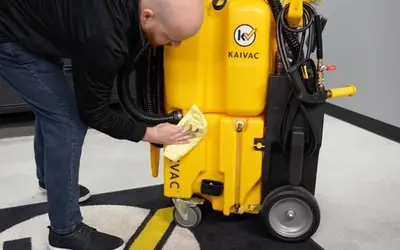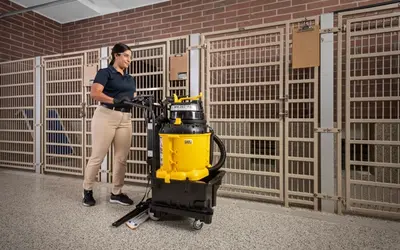How to Clean a Commercial Kitchen

Knowing how to clean a commercial kitchen is a big part of any restaurant’s success. Granted, running a restaurant has never been easy. But outside forces—the pandemic, the great resignation, and high food costs—challenge restaurant owners even further.
The result? “Restaurants across America are teetering on a precipice,” writes Corey Mintz in Business Insider. Mintz points to one glaring reason for the state of the industry: finding and retaining enough qualified workers.
Enticing employees back to restaurants will take a multi-pronged approach. Simplifying commercial kitchen cleaning can be a big help. Cleaning is one of the most important jobs for restaurant workers. It’s also one of the hardest, most unpleasant tasks they face.
Here’s how to make cleaning a commercial kitchen faster, easier, and more satisfying.
Despite Challenges Statistics Point to Growth
The good news is restaurants continue to thrive in this tough business environment. The National Restaurant Association reports that:
- The foodservice industry is forecast to reach $1 trillion in sales in 2024.
- Competition remains strong, with operators expecting rivalries to stay intense.
- People still love restaurants. Nine out of 10 adults report enjoying going out to eat.
Yet those consumers remain demanding and are willing to choose restaurants based on their past dining experience. QSR Magazine reports that:
- 80% of customers consider alternatives after just one bad brand experience.
- 72% of customers spend more on companies that get the consumer experience right.
- 80% recommend brands based on consistently positive customer experiences.
Staffing Woes Compound Problems
Restaurants have always had trouble finding and retaining staff. Online ordering and reservation software company Toast finds that, using the most recent data as of January 2024, the average annual restaurant industry turnover rate is 74%. Surprisingly, that is the lowest annual rate since 2017.
Food service workers site three reasons for the churn. Their pain points—low hourly pay, bad managers, and no recognition for hard work—are understandable and predictable. No one wants to work hard for little money and less respect. Finding ways to retain these workers will help both sides. Restaurant owners will save money spent on finding and training new staff. Employees will feel empowered and enthusiastic about all aspects of the job.
Danger of a Dirty Kitchen
Empowering employees to do their best when cleaning and recognizing that effort is very important. After all, not many people love cleaning, particularly greasy kitchen messes. Making the task easier comes with rewards.
Alternatively, dirty restaurant kitchens come with consequences. The list of common bacteria and viruses that cause food poisoning is long and scary, including E. coli, salmonella, and norovirus. News of a failed health inspections or a bad restaurant score travels fast. News about outbreaks of food-borne illness at a restaurant travels even faster.
Greasy kitchen floors can also cause issues in restaurant kitchens. Grease from grills and fryers ends up everywhere in a kitchen. Equipment, walls, hoods, and floors can all end up slick or sticky with hardened grease. This can lead to accidents. In fact, each year, more than 3 million foodservice employees and 1 million guests are injured as the result of a slip-and-fall accident. It is estimated that the foodservice industry spends more than $2 billion each year for such injuries and that number rises by 10% every year.
Tips on Maximizing Cleaning with Fewer Employees
Commercial kitchen cleaning is fundamental to restaurant success. It is also hard and unpleasant, particularly if overworked and underpaid staff must take on the job. Savvy restaurant owners can empower workers with technology that does a better job.
Cleaning checklists will have you “sweep and mop” your kitchen floor, but the task is not as simple as it sounds. After sweeping you must remove all accumulated grease, or your floor will remain a slippery safety hazard. Trying to do that with a traditional bucket and mop not only leaves the grease in place, it will spread it around to other parts of your facility.
Grease removal requires the right chemicals, the right approach and patience. A properly diluted degreaser needs time to emulsify (dissolve) grease, soils, and oil to be effective. Read directions carefully and dilute the chemicals as directed. Apply to the floors and let dwell accordingly. Once ready, use a deck brush to loosen soils.
Grease can never be fully removed if your protocol includes a mop and bucket. Instead, the mop leaves a layer of dirt, grease, and chemical residue behind. These dried soils coat the floor, soak into grout lines, and leave your floor slippery and unsanitary.
Newer technologies, like the UniVac® from Kaivac, can fully remove grease and other contaminants from your facility. The tool is faster and easier to use than a traditional mop and bucket, saving time and effort. And training is easy so employees can start cleaning completely right away.
The UniVac has been embraced by industry leaders looking to streamline their cleaning operations. Restaurants like Popeyes and Dairy Queen have also turned to the UniVac for superior cleaning outcomes. The staff enjoy using the machine too.
“Trainees come in expecting a mop and bucket,” says Jennifer Spencer, owner of a Dairy Queen Grill and Chill. “So, when they see the UniVac their eyes get really wide.”
The delight only increases from there. Staff appreciate that using the UniVac means no bending, twisting, or scrubbing on their hands and knees.
“I hear a lot less complaining about having to clean the floor,” Spencer says.
Related Posts

Preventive Maintenance for Your No-Touch Cleaning® System
Your Kaivac No-Touch Cleaning system makes restroom maintenance fast and easy. Keeping your No-Touch Cleaning system in good working order is also fast and easy. Kaivac makes performing preventative maintenance and troubleshooting potential issues simple. No special equipment or technical expertise required.
Read more
The Best Dog Kennel Cleaning Equipment
There are ways to simplify the kennel cleaning process. Automatic kennel cleaning equipment can simplify the kennel cleaning process and can save hours of daily, back breaking labor–even for facilities without central drains.
Read more
A Better Retail Floor Care Option: How One National Retailer Reclaimed Floor Care
Discover how a national retailer cut costs and improved results by switching to Kaivac’s All Floor™ system—an easy, all-in-one floor care solution perfect for low-revenue retail locations.
Read more